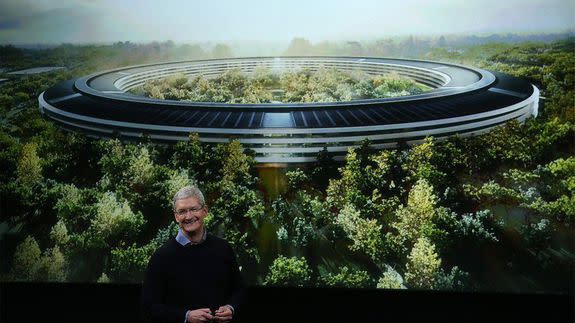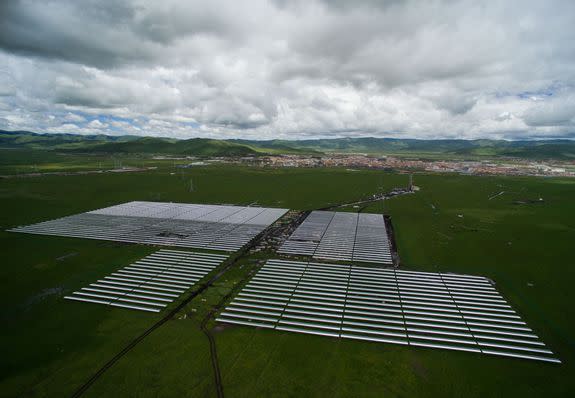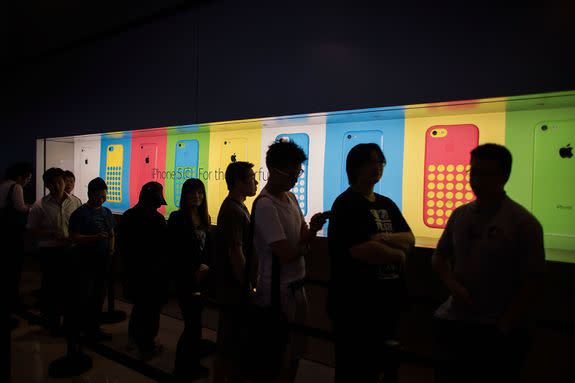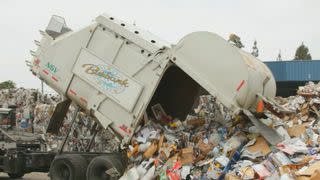Apple is investing $1 billion in clean energy with this unique approach

Apple just announced a big clean energy investment on the heels of President Trump's decision to withdraw the U.S. from the Paris Climate Agreement.
The iPhone maker, which supported the landmark climate pact, issued a $1 billion "green bond" on Tuesday. The bond will allow the company to finance projects such wind and solar power plants, energy-efficient buildings, and new approaches to using recycled materials.
SEE ALSO: China just built the world's biggest floating solar project
The California tech giant has been at the forefront of this young but increasingly popular investment trend since it issued a $1.5 billion green bond last year.
Apple's original bond was the first issued by any U.S. tech company, and it remains the largest green bond issued by a U.S. corporation. Following Tuesday's issuance, Apple will be the biggest issuer of green bonds pegged to the U.S. dollar.

Image: JUSTIN SULLIVAN/GETTY IMAGES
With green bonds, companies can finance renewable energy projects by issuing debt, rather than digging into their cash reserves. The concept is catching on in the U.S. and around the world.
Private and government organizations issued a total of $81 billion in green bonds in 2016, up from just $3 billion in 2012, according to the Climate Bonds Initiative, a nonprofit that promotes the debt investment tool. Issuances could reach a record $150 billion in 2017, the group said.
Apple's green bond is the first that's been issued since Trump's June 1 announcement on the Paris agreement, which commits the world to reducing greenhouse gas emissions.
In response, tech leaders — including Apple CEO Tim Cook — have joined with U.S. city officials, governors, and businesses over the past two weeks to voice support for the agreement and to commit to curbing emissions and investing in clean energy.
Decision to withdraw from the #ParisAgreeement was wrong for our planet. Apple is committed to fight climate change and we will never waver.
— Tim Cook (@tim_cook) June 2, 2017
"Leadership from the business community is essential to address the threat of climate change and protect our shared planet," Lisa Jackson, Apple's top executive on environmental issues and former head of the U.S. Environmental Protection Agency, said on Tuesday in an emailed statement.
Apple's latest green bond "will support Apple’s ongoing work to lower greenhouse gas emissions, drive renewable energy investment, and conserve precious resources," she added. "We're proud to offer investors another opportunity to join us in this important work."
The $1 billion bond will help finance projects that fall within Apple's three environmental priorities: reducing its climate impact by using renewables and driving efficiency in its facilities, products, and supply chain; pioneering the use of safer materials in its products and processes; and conserving natural resources such as minerals and water, the company said.

Image: Stringer/REX/Shutterstock
The MacBook and iPhone maker already gets 96 percent of its electricity globally from renewable energy sources. Facilities in 24 countries, including the U.S., are powered by 100-percent renewables.
But Apple's operations are only a slice of the company's overarching carbon footprint. Through its third-party suppliers, manufacturing accounted for about 77 percent of Apple's total carbon emissions in 2016, the company said.
To that end, the tech giant is partnering with far-flung suppliers to reduce emissions from factories and manufacturing sites. Eight major suppliers have committed to powering all of their Apple-related operations with renewable energy, including most recently Jabil Circuit Inc., which makes aluminum housing for the iPhone and other parts.

Image: Lam Yik Fei/Getty Images
Apple's latest bond offering also includes a focus on advancing Apple's goal of a closed-loop supply chain, where products are made using only renewable resources or recycled materials to avoid having to mine for new materials.
That particular focus speaks to the remaining gap in Apple's environmental strategy. While the company is ramping up efforts to cut carbon emissions from offices and factories, its endless rollout of new and improved products requires digging up the Earth for precious minerals. It also contributes to the world's growing heap of electronic waste.
Apple said it's making progress on this front, too. For instance, the company is transitioning to 100-percent recycled tin solder on the main logic board of the iPhone 6s. It has also melted down iPhone 6 aluminum enclosures to make Mac mini computers for use in its factories, the company said.
WATCH: How one company is transforming trash into clean energy

